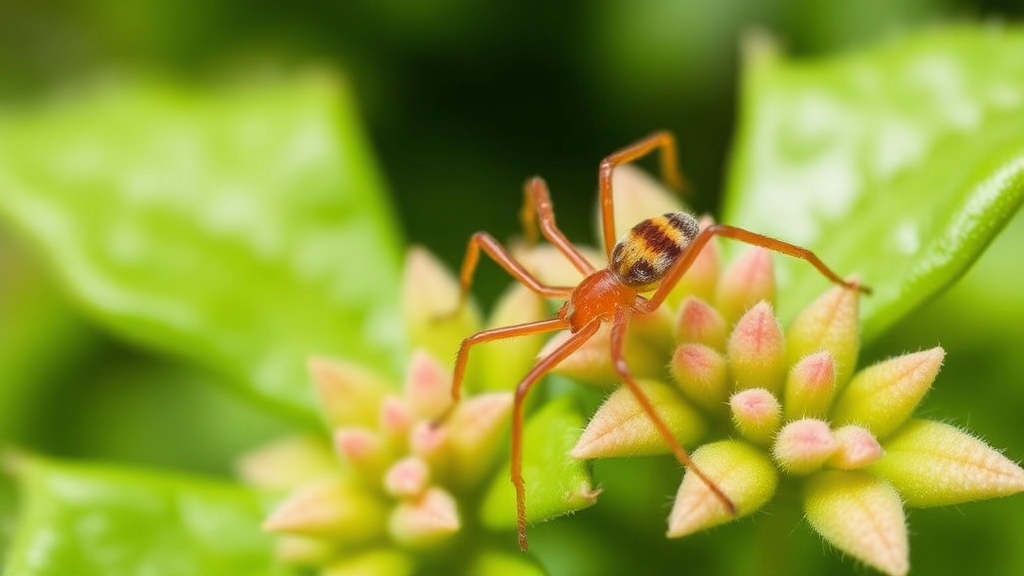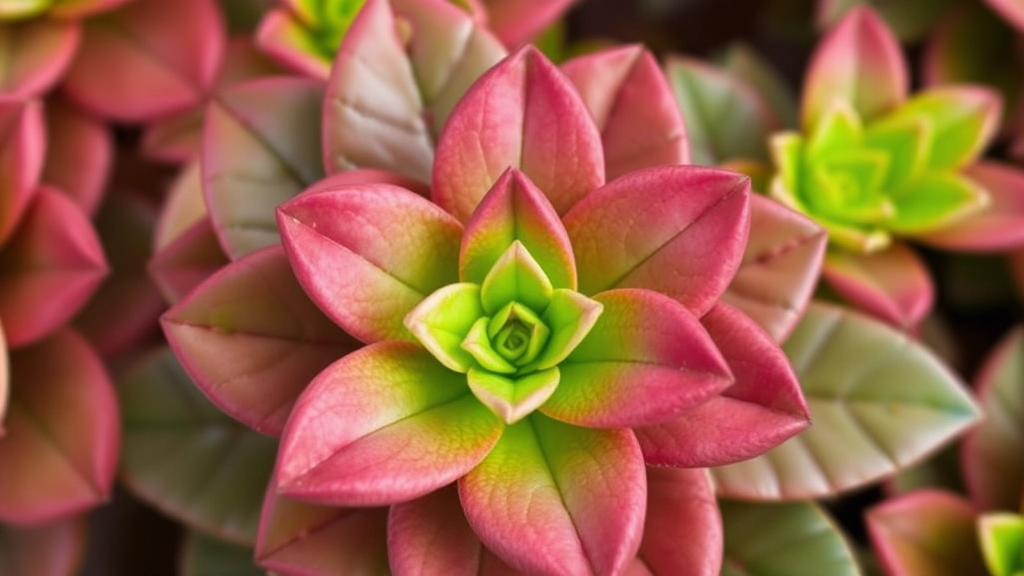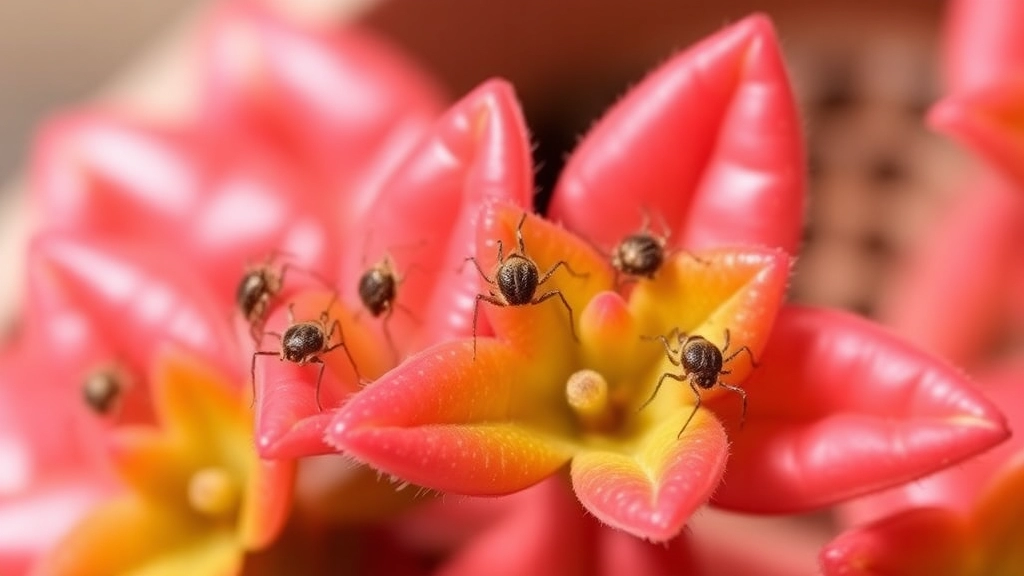Dealing with Kalanchoe Spider Mites
Dealing with Kalanchoe spider mites can be a real headache, but recognising the signs early can save your plant. Look out for tiny webs, yellowing leaves, and a general decline in plant health. These pests are small but mighty, making early detection crucial.
Natural Remedies
For natural remedies, consider using neem oil or insecticidal soap. Both are effective in managing spider mite populations without harming your plant. Regularly spraying these solutions can keep the infestation at bay.
Prevention Tips
Prevention is key, so ensure your Kalanchoe is well-watered and dust-free to discourage these pests from settling in.
Signs of Spider Mite Infestation on Kalanchoe
Are you noticing unusual changes in your beloved Kalanchoe?
Spider mites can be a real nuisance, and identifying their signs early is crucial for effective treatment.
Common Signs to Look For
- Webbing: Fine, silken webs may appear on the undersides of leaves or between branches. This is one of the most telling signs of spider mite activity.
- Discolouration: Leaves may show stippling, which looks like tiny yellow or white spots. This occurs as the mites feed on the plant’s sap.
- Leaf Drop: Affected leaves may become weak and eventually fall off. If you notice an unusual number of leaves dropping, it might be time to investigate further.
- Leaf Curling: Leaves may curl or become distorted due to the feeding damage. This can lead to overall poor plant health.
- Dusty Appearance: An overall dusty or dirty look on the foliage can indicate spider mites. This is often due to the webbing mixed with dust.
Monitoring Your Kalanchoe
Keep a close eye on your Kalanchoe, especially during warmer months when spider mites thrive. Regularly inspecting your plant can help you catch an infestation early, allowing for timely intervention. If you observe any of these signs, it’s essential to act quickly to protect your plant.
For further guidance on maintaining a healthy Kalanchoe, check out our expert tips on Kalanchoe care and learn about maximizing the longevity of your Kalanchoe.
Natural Remedies for Spider Mites on Kalanchoe

So, you’ve spotted those pesky spider mites on your Kalanchoe, and you’re probably wondering how to tackle this issue without reaching for harsh chemicals.
Let’s dive into some natural remedies that can help you out.
- Water Spray
Start with a strong jet of water.
This can dislodge spider mites from your plant.
Aim for the undersides of leaves where they love to hide.
Repeat this every few days until you notice fewer mites. - Diatomaceous Earth
This is a natural powder made from tiny fossilized aquatic organisms.
Sprinkle it around your plant, as it can dehydrate and kill spider mites on contact.
Just be careful not to overdo it, as too much can harm beneficial insects. - Garlic Spray
Blend a few cloves of garlic with water and strain it.
Spray this mixture on your Kalanchoe.
The strong scent can repel spider mites.
Plus, it’s a great way to keep your plant smelling fresh! - Peppermint Oil
Mix a few drops of peppermint oil with water in a spray bottle.
This not only smells amazing but also acts as a natural pesticide.
Spray it on your plant, focusing on the affected areas. - Essential Oils
Other essential oils like rosemary or tea tree oil can also work wonders.
Just mix a few drops with water and spray.
These oils have properties that deter spider mites effectively.
Using these natural remedies can be a game-changer, especially if you prefer to keep things eco-friendly.
Using Neem Oil and Insecticidal Soap Effectively
When dealing with spider mites on your Kalanchoe, many plant owners often wonder about the best natural solutions. Two of the most effective options are neem oil and insecticidal soap.
Why Choose Neem Oil?
Neem oil is derived from the seeds of the neem tree and is known for its insecticidal properties. It disrupts the life cycle of pests, making it a fantastic choice for combating spider mites.
How to Use Neem Oil:
- Dilution: Mix 1-2 tablespoons of neem oil with a litre of water.
- Add Soap: Incorporate a few drops of mild liquid soap to help the oil mix with water.
- Application: Spray the solution directly onto the affected areas of your Kalanchoe, ensuring you cover both the tops and undersides of the leaves.
Insecticidal Soap: A Quick Fix
Insecticidal soap is another excellent option. It works by suffocating the spider mites and disrupting their cell membranes.
How to Use Insecticidal Soap:
- Purchase Ready-Made Solutions: Look for commercially available insecticidal soaps.
- Homemade Option: Alternatively, mix 2 tablespoons of liquid soap with a litre of water.
- Application: Spray generously on the infested areas, repeating every 5-7 days until the infestation is under control.
Tips for Effective Use:
- Timing: Apply during cooler parts of the day to prevent leaf burn.
- Frequency: Reapply every week for best results, especially after rain or watering.
- Check for Sensitivity: Always test on a small leaf area first to ensure no adverse reactions occur.
Both neem oil and insecticidal soap can be potent allies in your battle against spider mites. For more detailed care tips, you might find our Ultimate Guide to Growing Kalanchoe Pink Flowers useful. Additionally, if you are interested in the medicinal properties of Kalanchoe, check out our article on Kalanchoe Blossfeldiana Medicinal and Decorative Uses.
Preventing Spider Mite Infestations in Kalanchoe

As we dive deeper into maintaining the health of your Kalanchoe, it’s essential to consider how to prevent spider mite infestations before they even start.
Common Concerns:
- How can I protect my Kalanchoe from spider mites?
- What environmental factors contribute to infestations?
Prevention Tips:
- Maintain Humidity:
- Spider mites thrive in dry conditions.
- Keep the humidity level around 40-60% for optimal plant health.
- Regular Watering:
- Ensure your Kalanchoe receives adequate water, but avoid overwatering.
- Check the soil moisture regularly to maintain a balance.
- Air Circulation:
- Position your Kalanchoe in a well-ventilated area.
- Good airflow helps deter spider mites by reducing stagnant air.
- Inspect New Plants:
- Always check new plants for pests before introducing them to your collection.
- Quarantine new plants for a couple of weeks to monitor any potential infestations.
- Clean Leaves:
- Wipe the leaves with a damp cloth regularly to remove dust.
- This makes it harder for spider mites to settle on the foliage.
- Companion Planting:
- Consider planting companion plants that naturally repel spider mites.
- Herbs like basil or marigolds can be effective.
- Avoid Over-Fertilizing:
- Excessive fertilisation can make plants more attractive to pests.
- Follow a balanced fertilisation schedule.
Best Practices for Long-Term Kalanchoe Health
Maintaining the health of your Kalanchoe is crucial, especially after dealing with spider mites. You want your plant thriving, not just surviving.
Here are some best practices to ensure your Kalanchoe remains healthy:
- Proper Watering:
- Allow the soil to dry out between waterings.
- Overwatering can lead to root rot, while underwatering can stress the plant.
- Optimal Lighting:
- Kalanchoes thrive in bright, indirect sunlight.
- Too much direct sunlight can scorch the leaves, while too little can weaken the plant.
- Humidity Control:
- Keep humidity levels moderate.
- If your home is particularly dry, consider misting the leaves occasionally.
- Regular Cleaning:
- Wipe leaves with a damp cloth to remove dust.
- This helps the plant breathe and allows it to absorb more light.
- Fertilisation:
- Use a balanced, water-soluble fertiliser during the growing season (spring and summer).
- Follow the package instructions to avoid over-fertilising.
- Pest Monitoring:
- Regularly inspect your Kalanchoe for signs of pests.
- Early detection allows for quicker intervention.
- Repotting:
- Repot every couple of years to refresh the soil and provide more space for growth.
- Choose a pot with good drainage to prevent waterlogging.
By implementing these practices, you can create a thriving environment for your Kalanchoe, making it less susceptible to infestations. For more detailed care tips, you can check out our Complete Care Guide for Kalanchoe Blossfeldiana and learn about the Causes and Solutions for Brown Spots on Kalanchoe Leaves.
When to Consider Professional Pest Control for Spider Mites
So, you’ve tried your hand at natural remedies and even dabbled with neem oil, but those pesky spider mites just won’t budge.
When’s the right time to call in the pros?
Here are some signs that it might be time to consider professional pest control for your Kalanchoe:
- Severe Infestation: If you notice a significant number of spider mites, especially if they’re spreading rapidly, it’s a red flag.
- Damage to the Plant: If your Kalanchoe leaves are wilting, yellowing, or dropping off, that’s a sign that the infestation is taking a toll.
- Limited Success with Home Remedies: Tried everything from soap sprays to essential oils and nothing seems to work? It might be time to escalate.
- Recurring Issues: If spider mites keep coming back despite your best efforts, it’s a cycle that needs breaking.
Why go professional?
- Expertise: Pest control professionals have the knowledge and tools to tackle infestations effectively.
- Safety: They know how to handle chemicals safely, ensuring your plant and home remain unharmed.
- Long-term Solutions: They can provide strategies to prevent future infestations, saving you time and hassle.
If you find yourself nodding along to any of these points, it might be a good idea to reach out for help. For more tips on maintaining healthy plants, check out our guide on fixing drooping Kalanchoe leaves and learn about why Kalanchoe leaves turn red.
FAQs About Kalanchoe and Spider Mites
What are spider mites and why are they a problem for Kalanchoe?
Spider mites are tiny pests that feed on the sap of plants, including Kalanchoe. They can cause significant damage by sucking out the plant’s nutrients, leading to yellowing leaves and stunted growth.
How can I identify spider mites on my Kalanchoe?
Look for tiny webbing on the undersides of the leaves and small, moving dots which are the mites themselves. You may also notice yellow or white spots on the leaves where the mites have been feeding.
What natural remedies can I use to get rid of spider mites on my Kalanchoe?
There are several natural remedies you can try:
- Water Spray: Use a strong jet of water to dislodge spider mites from the undersides of the leaves.
- Diatomaceous Earth: Sprinkle this natural powder around your plant to dehydrate and kill spider mites on contact.
- Garlic Spray: Blend garlic with water, strain, and spray the mixture on your Kalanchoe to repel spider mites.
- Peppermint Oil: Mix a few drops with water and spray on the affected areas to act as a natural pesticide.
- Essential Oils: Rosemary or tea tree oil mixed with water can also deter spider mites effectively.
How often should I apply these natural remedies?
It’s best to apply these remedies every few days until you notice a decrease in the spider mite population. Consistency is key to effectively managing the infestation.
What can I do to prevent spider mite infestations on my Kalanchoe?
Here are some preventive measures:
- Maintain Humidity: Keep the humidity level around 40-60% as spider mites thrive in dry conditions.
- Regular Watering: Ensure your Kalanchoe receives adequate water without overwatering. Check soil moisture regularly.
- Air Circulation: Place your Kalanchoe in a well-ventilated area to reduce stagnant air.
- Inspect New Plants: Always check new plants for pests and quarantine them for a couple of weeks before adding them to your collection.
- Clean Leaves: Wipe the leaves with a damp cloth regularly to remove dust and make it harder for spider mites to settle.
- Companion Planting: Plant herbs like basil or marigolds that naturally repel spider mites.
- Avoid Over-Fertilizing: Follow a balanced fertilisation schedule to avoid making your plants more attractive to pests.
Are there any environmental factors that contribute to spider mite infestations?
Yes, spider mites thrive in dry and warm conditions. Ensuring proper humidity, good air circulation, and regular watering can help create an environment less conducive to spider mite infestations.
Can I use chemical pesticides to get rid of spider mites on my Kalanchoe?
While chemical pesticides can be effective, they may also harm beneficial insects and the environment. Natural remedies are a safer and eco-friendly alternative.
References
-
How to Get Rid of Spider Mites on Kalanchoe
-
Natural Ways to Get Rid of Spider Mites
-
Spider Mites: How to Identify and Control Them
